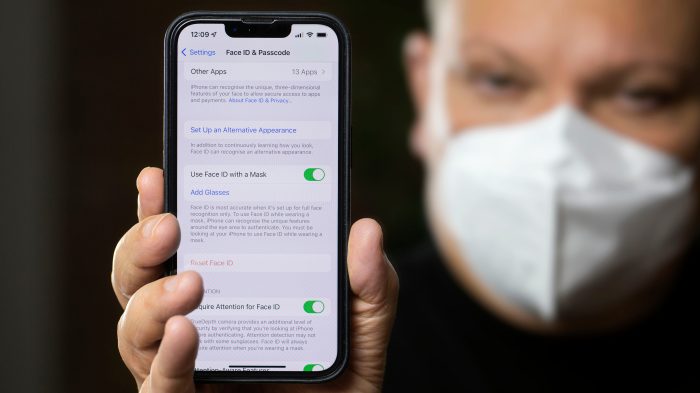The iPhone X’s Face ID Technology
The iPhone X marked a significant shift in smartphone security with the introduction of Face ID, a facial recognition system that revolutionized how users unlock their devices. Face ID uses advanced technology to create a secure and convenient way to authenticate users, offering a more natural and intuitive experience compared to traditional methods like passcodes or fingerprint scanning.
How Face ID Works
Face ID leverages a sophisticated system of hardware and software components to achieve accurate facial recognition. The process begins with the TrueDepth camera system, which comprises an infrared camera, a dot projector, and a flood illuminator. When a user attempts to unlock their device, the dot projector emits over 30,000 invisible infrared dots onto the user’s face. These dots create a depth map of the face, capturing its unique geometric structure. The infrared camera captures the user’s face in infrared light, which is less susceptible to ambient light conditions and provides more detailed information than visible light. The flood illuminator provides additional illumination in low-light environments, ensuring accurate face detection.
Comparison with Other Facial Recognition Technologies
Face ID’s security features distinguish it from other facial recognition technologies. Unlike traditional 2D facial recognition systems that rely on static images, Face ID utilizes 3D depth mapping, making it more resistant to spoofing attempts using photographs or masks. The use of infrared technology further enhances security by making it difficult to bypass the system using artificial lighting or makeup.
Security Features of Face ID
Face ID incorporates various security features to prevent unauthorized access.
- Secure Enclave: Face ID data is stored securely within the iPhone’s Secure Enclave, a dedicated processor that protects sensitive information. The Secure Enclave is isolated from the main processor and operating system, making it highly resistant to attacks.
- Attention Detection: Face ID requires the user to look directly at the device to unlock it, preventing accidental unlocking when the phone is not in use.
- Dynamic Face Mapping: Face ID continuously updates the user’s facial map, adapting to changes in appearance like hairstyles, glasses, or even facial hair. This ensures that the system remains accurate and secure over time.
Masking and Face ID
The widespread adoption of face masks during the COVID-19 pandemic has presented a significant challenge for Face ID technology, which relies on recognizing specific facial features. Masks cover a substantial portion of the face, hindering the ability of Face ID to accurately identify individuals.
Impact of Masks on Face ID Accuracy
Masks pose a substantial obstacle to Face ID’s functionality, significantly impacting its accuracy. This is primarily due to the occlusion of key facial features that Face ID relies on for recognition. The face mask covers the nose and mouth, which are essential components used by Face ID for identifying individuals.
- Reduced Recognition Area: Face ID utilizes a complex algorithm that maps and analyzes various facial features. The presence of a mask significantly reduces the area of the face that can be recognized, making it challenging for the system to accurately identify an individual.
- Disruption of Facial Feature Recognition: The nose and mouth are crucial for facial recognition as they contain unique characteristics. Masks obscure these features, hindering Face ID’s ability to perform accurate identification.
- Increased False Rejection Rate: The presence of a mask can lead to an increase in the false rejection rate of Face ID. The system might fail to recognize a registered user, requiring alternative authentication methods, such as passcode entry.
Examples of Face ID Challenges with Masks
Numerous real-world scenarios illustrate the difficulties posed by masks for Face ID.
- Unlocking iPhones: Many iPhone users have experienced difficulty unlocking their devices while wearing masks. Face ID may fail to recognize them, requiring them to enter their passcode instead.
- Mobile Payment Applications: Some mobile payment applications, such as Apple Pay, rely on Face ID for authentication. Wearing a mask can disrupt this process, preventing users from making seamless payments.
- Security Access: In scenarios where Face ID is used for security access, such as unlocking doors or accessing restricted areas, masks can pose a significant challenge.
Workarounds and Solutions
The widespread adoption of face masks during the COVID-19 pandemic presented a significant challenge for Face ID, which relies on recognizing the unique features of a user’s face. While Apple acknowledged the issue and has implemented workarounds, it is crucial to explore alternative solutions and future adaptations to enhance Face ID’s functionality in a masked world.
Apple Watch Authentication
Using an Apple Watch as an authentication method provides a practical workaround for Face ID limitations when wearing a mask. The Apple Watch utilizes a different authentication system based on a passcode or Touch ID, allowing users to unlock their iPhone without relying on facial recognition.
Apple Watch authentication offers a seamless and secure alternative for unlocking iPhones when masks are worn.
- Users can pair their Apple Watch with their iPhone to enable automatic unlocking.
- When a mask is detected, the iPhone prompts the user to unlock using their Apple Watch, providing a convenient and secure solution.
- This approach ensures the security of the device while accommodating the need to wear masks.
Future Adaptations of Face ID
While Apple Watch authentication offers a temporary solution, future adaptations of Face ID are necessary to address the growing need for facial recognition in a masked world. Apple is continuously exploring advancements in facial recognition technology, with potential solutions including:
- Improved Mask Detection: Enhancing the ability of Face ID to recognize and distinguish between masked and unmasked faces. This could involve leveraging advanced algorithms and machine learning techniques to identify facial features that remain visible even with a mask.
- Eye Recognition: Focusing on recognizing unique features of the eyes, which are typically not covered by masks. This approach would require significant advancements in eye recognition technology and algorithms to ensure accuracy and security.
- Combined Face and Mask Recognition: Developing a hybrid system that recognizes both the face and the mask. This could involve analyzing the shape, color, and pattern of the mask to create a unique identifier, supplementing the traditional facial recognition process.
Privacy and Security Concerns: Iphone X Used To Mask Face
While Face ID offers a convenient and secure way to unlock your iPhone, wearing a mask presents a unique challenge to this technology. The use of masks, particularly during the COVID-19 pandemic, has raised concerns about the potential privacy and security implications of Face ID.
The reliance on facial recognition technology for authentication introduces vulnerabilities when masks obscure a significant portion of the face. This vulnerability could allow unauthorized individuals to gain access to your device, potentially compromising your sensitive data and privacy.
For example, a person with a similar facial structure to yours could potentially gain access to your iPhone by wearing a mask that hides their unique features. While Apple has implemented safeguards to mitigate this risk, the potential for unauthorized access remains a valid concern.
Social and Cultural Impact
The widespread adoption of face masks during the COVID-19 pandemic has significantly impacted the use of Face ID technology on iPhones. While Face ID was initially lauded for its convenience and security, the requirement to wear masks has presented a significant challenge, leading to a noticeable shift in user experience and raising broader questions about technology and privacy.
Impact on Daily Life
The inability to unlock iPhones with Face ID while wearing a mask has become a commonplace frustration for many users. This has led to a number of workarounds, such as entering passcodes, using Apple Watches, or removing masks entirely in certain situations. The constant need to switch between these methods has created a sense of inconvenience and, in some cases, even anxiety, especially in situations where time is of the essence.
Iphone x used to mask face – The mask-related challenges of Face ID highlight the complex interplay between technology, privacy, and social norms. As we navigate a world where masks are increasingly integrated into our lives, it’s crucial to consider the evolving security landscape and the potential vulnerabilities that arise. While workarounds exist, the future of Face ID, and indeed facial recognition technology in general, hinges on finding innovative solutions that balance security, convenience, and privacy in an increasingly mask-dependent world.
Remember the iPhone X and its Face ID feature? It was all the rage, with everyone talking about how secure it was. But then Motorola came along and threw a wrench in the works with the Moto Z Droid, a phone that could trick Face ID with a simple mask. This little trick made a lot of Apple fans question the security of Face ID, proving that even the most advanced technology can be outsmarted.
And let’s be honest, the whole “masking your face” thing just felt a little too futuristic, like something out of a sci-fi movie.
 Standi Techno News
Standi Techno News

